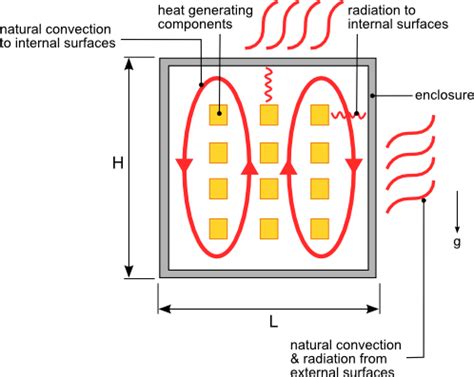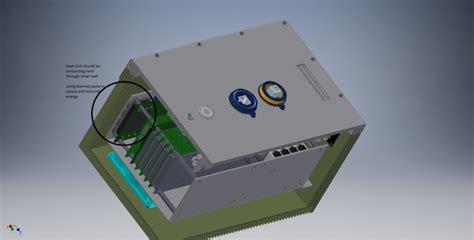how much heat power supply enclosure electrical Use our free Enclosure Cooling Calculator to determine heat load and find the right thermal management solution to meet your requirements. Click to get started! Add a touch of nostalgia to your collection with this vintage Kemp's Step Ahead Nuts tin box. The tin box features a black and white design that is perfect for any collector of candy and nut-themed merchandise.
0 · heat dissipation in sealed enclosures
1 · heat dissipation in enclosure
Check out our vintage jack in the box selection for the very best in unique or custom, handmade pieces from our wind-up toys shops.
Calculating an electrical enclosure's heat dissipation rate is the first step to prolonging the life of your electrical components. Use the following information to calculate input power and . So my guess is that the correct way to calculate would be to use the power efficiency, η to calculate, where (1-η) x 3.41 x Watts = BTU/hr. For .
impact lube kit for metal housing impacts
Estimated internal heat load is: Device Power = 115 x 15 = 1725 W Total Power = 2 x 1725 = 3450 Less Efficiency = 3450 x (1 - .90) Total Heat Load = 345 W Utilize component efficiency to . Use our free Enclosure Cooling Calculator to determine heat load and find the right thermal management solution to meet your requirements. Click to get started!A common power supply cooling solution when using a sealed enclosure is to use a small convection cooled power supply and over-rate it. For example, if you take a power supply that is rated for full power at 50°C ambient temperature, it .
This enclosure heat calculator allows a user to input anticipated watts, finished surface, and enclosure dimensions to detail heat rise. Anticipated watts derive from power-consuming devices inside the panel.
illustrator distribut spacing text box where
How to Calculate Heat Load in Electrical/Electronic Panel Enclosure. by Editorial Staff. Total heat load consists of the heat transfer from outside your panel and from the heat dissipated inside the control unit. Useful terms & Conversions: 1 .A good quality solder joint should be as good as or better than the wire in terms of heat build up. . that he's just adding enough distance to locate the power supply outside of the enclosure, then we're probably looking at an extra 2 ft of wire .Motor operates from 24V 10 Amp power supply, and -4°F to 176° F operating temperature. Our testing ambient temperature averaged 71°F. . I just need a way to prevent the motor from creating too much heat in the enclosure. . I . I have some Meanwell HLG-320H-12A 264 Watt LED Power Supplies that get arranged within an electrical enclosure. Is there a proper spacing between them that is required by an NEC code somewhere. . If the power supplies are UL listed, the minimum air space / separation would have been part of the heat rise testing for UL listing. So somewhere .
ikea steel display cabinet
Electrical panels generate heat due to current flow and resistance in components. Excessive heat can indicate problems like overloading or loose connections, potentially leading to circuit damage or fires. Monitoring panel temperature, proper ventilation, and regular inspections are essential for safe operation, ensuring the temperature remains within manufacturer .
$\begingroup$ The most difficult part is knowing the rate at which you lose heat to the surrounding air. But good thing you don't need to know since your temperature rise low, your volume is small, and time fairly long. I'd just get an element I know is vastly overpowered like a 500W or 1000W element and use feedback to turn the element off when the temperature is .Example: Find the expected temperature rise from a 48″ x 36″ x 16″ electric enclosure with 300 watts of heat dissipated. Calculate Surface Area: 2 x ((48 x 36) + (48 x 16) + (36 x 16)) / 144 = 42 ft 2 Determine Input Power: 300 watts / 42 ft 2 = 7.1 watts/ft 2 Use the graph to find the Temperature RiseIn the first instance, a 300 W power supply operating at full load with an efficiency of 85 percent will dissipate 53 W in heat, whereas a 90 percent efficient supply will waste 20 W less in power converted to heat, potentially reducing or even eliminating the need for airflow-based cooling. Free Standing Electrical Enclosure; Outdoor & Indoor. Outdoor Electrical Enclosure; Indoor Electrical Enclosure; Metal Enclosure. Enclosure With Windows; Vented Enclosure; Sloped Top Enclosure; Wiring Trough Enclosures; Push-button Enclosures; Hinged Electrical Enclosures; Steel Electrical Enclosure. 304 Stainless Steel Enclosure; 316 Stainless .
It is less costly to buy an enclosure and a power supply and put it together and test to see what happens than to play 200 questions to coax out what the actual use is going to be. If the PCB produces no heat, it doesn't need a 120 Watt .
Example: Find the expected temperature rise from a 48″ x 36″ x 16″ electric enclosure with 300 watts of heat dissipated. Calculate Surface Area: 2 x ((48 x 36) + (48 x 16) + (36 x 16)) / 144 = 42 ft 2 Determine Input Power: 300 watts / 42 ft 2 = 7.1 watts/ft 2 Use the graph to find the Temperature Rise

this is only going to have a tiny control transformer in it and maybe a small 24VDC power supply. so they might give me what, about 100Watts heat? I haven't picked all of the components out yet, but i do have one that has a -5 degree minimum ambient temp. so i at least will have to keep the cabinet at least that warm when it's -35 outside.speed, the fan delivers 50% of its rated airflow but requires only 1/8 full-load power. Even with a reduced motor efficiency of 77.8% and drive efficiency of 86%, with adjust-able speed operation the power required by the fan and the VFD is only 2.8 kW. For this example, input power requirements are reduced by 82.9%.
heat dissipation in sealed enclosures
heat dissipation in enclosure
FET and/or heatsink cannot attach to the enclosure; FET used is: . NASA report of a MOSFET failure in a power supply citing the Spirito effect. Share. Cite. Follow edited Dec 21, 2019 at 15:50 . I think it is more likely a heat dissipation issue. $\endgroup$ – user2608147. Commented Feb 17, .Wattage Calculator. The wattage of the heater you need is determined by the total surface area of your enclosure and the temperature rise you need to produce. You can use this calculator to find the wattage you need. (Note: This calculator has a maximum temperature rise of 140°F or 78°C)Step 1: Find your enclosure's total surface area by entering its dimensions here.
One of the most important things to consider when selecting an electrical enclosure is the NEMA rating. NEMA stands for National Electrical Manufacturer Association. They have developed a rating system which determines the types of environments an electrical enclosure can be used in. NEMA 1 and a NEMA 12 enclosures
Total internal power is 10 hp x 2544 BTU/hp = 25440 BTU/hr plus 100 watts x 3.415 BTU/hr/watt = 25782 BTU/hr. Assume 10% forms heat = an internal heat load of 2578 BTU/hr. External heat load: The temperature difference between . After a discussion it is best to use a switching supply with enclosure already around it (being an amateur): 5V 3W mini power supply module Hi-Link HLK-PM01. . You will have much smaller heat problems if you use a .Electrical equipment that distributes power has a heat loss due to the impedance and/or resistance of its conductors. This heat is radiated into the electrical room where the equip-ment is placed and must be removed to ensure excess heat does not cause failures. Table 1.7-1 provides heat loss in watts for typical power distribution
Does hardware efficiency play a role in how much of the power drawn gets turned to heat? E.g. a newer architecture CPU drawing 150w from the wall might only output 80W of heat, while an older CPU pulling 150w might output 100w of heat. . We only need to supply the excess in electrical power, to keep the machine running. That's why for example .
An electrical enclosure is a cabinet for electrical or electronic equipment to mount switches, knobs and displays and to prevent electrical shock to equipment users and protect the contents from the environment. . Power Supplies Education. Relays Education . Electronic packaging may place many demands on an enclosure for heat dissipation .Power Supplies Education. Relays Education. Solar Education. . An electrical enclosure is simply a Cabinet that is designed to house various different types of electrical components as you can see here. Also, another main function of an electrical enclosure is gonna be to protect the instruments and components housed within the enclosure .
It’s supposed to draw 5v=1a from the supplied cable in order to provide power to the enclosure. The unit is supposed to house and power 2 2.5HDD or 2.5SSD drives simultaneously however, the problem is if I try and use 2 of the older HDD inside they draw too much power and won’t power up the unit. Putting It All Together. If we assume an ambient air temperature of 38 C (100 F) and a maximum power of 2 W all of the numbers we need have been collected. Then, based on that information I can find a power supply that is a good match. I'll also make a circuit that measure's temp and turns power on or off to maintain that temperature. . You need to have something in between which is a good electric conductor but a very bad heat conductor, otherwise things will end up badly. Share. Cite. Follow

Industrial facilities have lots of enclosures housing automation and electrical components, many of which need cooling and heating. . Often from the same components that can be damaged by too much heat including power supplies, AC drives/inverters, transformers, communication devices, battery back-up systems, soft starters, PLCs and HMIs. .
Example: Find the expected temperature rise from a 48″ x 36″ x 16″ electric enclosure with 300 watts of heat dissipated. Calculate Surface Area: 2 x ((48 x 36) + (48 x 16) + (36 x 16)) / 144 = 42 ft 2 Determine Input Power: 300 watts / 42 ft 2 = 7.1 watts/ft 2 Use the graph to find the Temperature Rise I agree that a TO-220 without a heatsink can't dissipate much heat (IRF640N datasheet estimates 62 C/W), but TO-220s get used all the time for power electronics. $\endgroup$ – Jason S Commented Jun 22, 2011 at 1:09
ikea stainless steel rectangle box
ikea steel cabinets
Vintage 20" 2 Speed ESKIMO Box Fan with the original box (All Metal Works Great)Fan is in good working condition . from
how much heat power supply enclosure electrical|heat dissipation in sealed enclosures